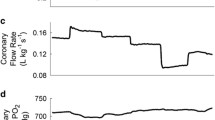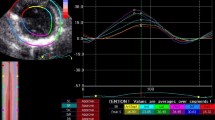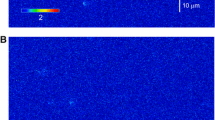Abstract
Although hypercholesterolemia is a well-known risk factor for atherosclerosis, little is known about the effect of hypercholesterolemia on cardiac contractile function. The objective of this study was to examine the effect of hypercholesterolemia on myocardial contractility. Fifteen New Zealand white rabbits were fed standard chow (control group) and another 15 were fed a cholesterolenriched diet (HC group) for 12 weeks. The contractile response of ventricular muscle strips was measured in various extracellular calcium concentrations and at different pacing rates. The whole-cell calcium current recording, and mRNA and protein levels of cellular calcium-handling proteins were also analyzed. With 2 mM Ca2+ and stimulation at 3 Hz, the contractile force of HC strips was less than that of the controls (3.63±0.20 vs. 4.61±0.50 mN, p<0.05). The time to peak tension was longer for HC strips (93.3±2.16 vs. 82.2±2.81 ms, p < 0.05). The peak L-type calcium inward current density was slightly higher in HC myocytes but did not reach statistical significance (−14.90±0.94 vs. −12.44±0.84 pA/pF, p=0.15). The mRNA level of sarcoplasmic reticulum Ca2+-ATPase (SERCA), normalized to GAPDH, was significantly lower in the HC than that in the control group (2.85±0.14 vs. 7.67±0.67, p<0.05), as was the ryanodine receptor (RyR; 0.42±0.06 vs. 0.71±0.13, p<0.05). The mRNA of the Na+/Ca2+ exchanger (NCX) was statistically higher in the HC group (0.90±0.12 vs. 0.48±0.05, p<0.05). Western blot experiments revealed that protein expression of SERCA in the HC strips decreased, but that of the NCX increased. The protein expression of the dihydropyridine receptor was similar between these two groups. We concluded that hypercholesterolemia results in suppression of the maximal contractile function and in a longer systolic contractile time course. These changes may partially be mediated through a decrease in SERCA and RyR but an increase in NCX expression.
Similar content being viewed by others
References
Anitschkow N, Chalatow S. Über experimentelle Cholesterinsteatose und ihre Bedeutung für die Entstehung einiger pathologischer Prozesse. Zentralbl Allg Pathol Anat 24(1):1–9;1913.
Bassani RA, Bassani JWM, Bers DM. Relaxation in rabbit and rat cardiac cells: Species-dependent differences in cellular mechanisms. J Physiol 476:279–293;1994.
Bastiaanse LE, Atsma D, Kuijpers M. The effect of sarcolemmal cholesterol content on intracellular calcium ion concentration in cultured cardiomyocytes. Arch Biochem Biophys 313:58–63;1994.
Bentley KI, Henry PD. Susceptibility of atherosclerotic heart to ischemia. Clin Res 29:177A;1981.
Bers DM. Calcium fluxes involved in control of cardiac myocyte contraction. Circ Res 87:275–281;2000.
Bers DM. Cardiac excitation-contraction coupling. Nature 415:198–205;2002.
Bers DM. Cardiac Na/Ca exchange function in rabbits, mouse and man: What's the difference? J Moll Cell Cardiol 34:369–373;2002.
Blumlein S, Sievers R, Parmley WW. Lack of decreased contractility in hearts from atherosclerotic rabbits. Am Heart J 106:1383–1388;1983.
Dhalla NS, Pierce GN, Panagia V, Singal PK, Beamish RE. Calcium movements in relation to heart function. Basic Res Cardiol 77(2):117–39;1982.
Fabiato A. Calcium-induced release of calcium from the cardiac sarcoplasmic reticulum. Am J Physiol 245:C1-C14;1983.
Go LO, Moschella MC, Watras J, Handa KK, Fyfe BS, Marks AR. Differential regulation of two types of intracellular calcium release channels during end-stage heart failure. J Clin Invest 95:888–894;1995.
Huang Y, Walker KE, Hanley F, Narula J, Houser SR, Tulenko TN. Cardiac systolic and diastolic dysfunction after a cholesterol-rich diet. Circulation 109:97–102;2004.
Igarashi-Saito K, Tsutsui H, Yamamoto S, Takahashi M, Kinugawa S, Tagawa H, Usui M, Yamamoto M, Egashira K, Takeshita A. Role of SR Ca2+-ATPase in contractile dysfunction of myocytes in tachycardia-induced heart failure. Am J Physiol 275(1 Pt 2):H31-H40;1998.
Ignatowsky MA. Influence de la nourriture animale sur l'organisme des lapins. Arch Med Exp Anat Pathol 20:1–21;1908.
Karp D, Rinzler SH, Travell T. Effects of ergometrine (ergonovine) on the isolated atherosclerotic heart of the cholesterol-fed rabbit. Br J Pharmacol 15:333–346;1960.
Kutryk MJ, Pierce GN. Stimulation of sodium-calcium exchange by cholesterol incorporation into isolated cardiac sarcolemmal vesicles. J Biol Chem 263(26):13167–13172;1988.
Le Grand B, Vie B, Faure P, Degryse A-D, Mouillard P, John GW. Increased resistance to ischemic injury in the isolated perfused atherosclerotic heart of the cholesterol-fed rabbit. Cardiovasc Res 30:689–696;1995.
Liu YB, Wu CC, Lu LS, Su MJ, Lin CW, Lin SF, Chen LS, Fishbein MC, Chen PS, Lee YT. Sympathetic nerve sprouting, electrical remodeling, and increased vulnerability to ventricular fibrillation in hypercholesterolemic rabbits. Circ Res 92:1145–1152;2003.
Luo TY, Wu CC, Liu YB, Fu YK, Su MJ. Dietary cholesterol affects nerve function in rabbit hearts. J Biomed Sci 11:339–345;2004.
Marx SO, Reiken S, Hisamatsu Y, Jayaraman T, Burkhoff D, Rosemblit N. PKA phosphorylation dissociates FKBP 12.6 from the calcium release channel (ryanodine receptor): Effective regulation in failing hearts. Cell 101:365–376;2000.
O'Rouke B, Kass D, Tomaselli G, Kaab S, Tunin R, Marban E. Mechanisms of altered excitation-contraction coupling in canine-induced heart failure. I. Experimental studies. Circ Res 84:562–570;1999.
Ortega A, Mas-Oliva J. Cholesterol effect on enzyme activity of the sarcolemmal (Ca2+, Mg2+)-ATPase from cardiac muscle. Biochim Biophys Acta 773(2):231–236;1984.
Otsu K, Willard HF, Khanna VK, Zorzato F, Green M, Maclennan DH. Molecular cloning of cDNA encoding the Ca2+ release channel (ryanodine receptor) of rabbit cardiac muscle sarcoplasmic reticulum. J Biol Chem 265:13472–13483;1990.
Peterson DW, Griffith DW, Napolitano CA. Decreased myocardial contractility in papillary muscles from atherosclerotic rabbits. Circ Res 45:338–346;1979.
Peterson DW, Napolitano CA, Griffith DW Jr. Spontaneous mechanical alternans in papillary muscles from atherosclerotic rabbits. Am J Physiol 239(5):H674-H680;1980.
Schillinger W, Schneider H, Minami K, Ferrari R, Hasenfuss G. Importance of sympathetic activation for the expression of Na+-Ca2+-exchanger in end-stage failing human myocardium. Eur Heart J 23:1118–1124;2002.
Studer R, Reinecke H, Bilger J, Eschenhagen T, Bohm M, Hasenfuss G, Just H, Holtz J, Drexler H. Gene expression of the cardiac Na-Ca exchanger in end-stage human heart failure. Circ Res 75:443–453;1994.
Wier WG, Balke CW. Ca2+ release mechanisms, Ca2+ sparks, and local control of excitation-contraction coupling in normal heart muscle. Circ Res 85:770–776;1999.
Winslow R, Rice J, Jafri S, Marban E, O'Rourke B. Mechanisms of altered excitation-contraction coupling in canine tachycardia-induced heart failure. II. Model studies. Circ Res 84:571–586;1999.
Wu CC, Su MJ, Chi JF, Chen WJ, Hsu HC, Lee YT. The effect of hypercholesterolemia on the sodium inward currents in cardiac myocyte. J Moll Cell Cardiol 27:1263–1269;1995.
Yeagle PL. Cholesterol and the cell membrane. Biochim Biophys Acta 822(3–4):267–287;1985.
Zarain-Herzberg A, Maclennan DH, Periasamy M. Characterization of rabbit cardiac sarco(endo)plasmic reticulum Ca2+-ATPase gene. J Biol Chem 265:4670–4677;1990.
Author information
Authors and Affiliations
Rights and permissions
About this article
Cite this article
Luo, TY., Su, MJ., Yang, YF. et al. Effect of hypercholesterolemia on myocardial function in New Zealand white rabbits. J Biomed Sci 11, 829–837 (2004). https://doi.org/10.1007/BF02254368
Received:
Accepted:
Issue Date:
DOI: https://doi.org/10.1007/BF02254368




